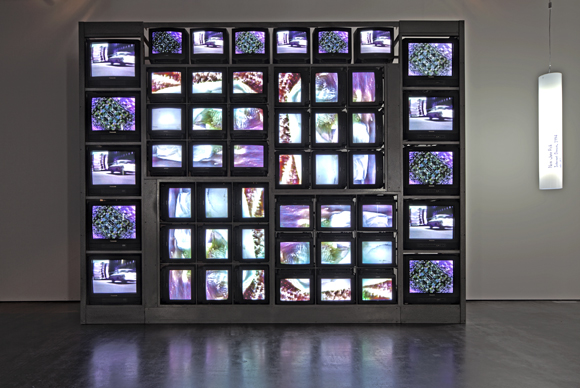|
Internet Dream, 1994
Nam June Paik

Internet Dream, a “videowall” by Nam June Paik, consists of a total of 52 monitors together forming a large unified image surface on which a shifting patchwork of electronically-processed images from three separate video sources is shown. As part of this bank of 52 screens, four smaller image-surfaces, each composed of nine monitors, all show the same image from the first image source, but on each one of the four, the image has a different orientation. Sixteen monitors surround this formation, showing in turn images from the other two image sources. The work was originally commissioned by the television broadcaster RTL, for the foyer of their headquarters in Cologne. At the time of RTL’s move to Berlin the work was donated to the ZKM.
Internet Dream belongs to the late work of the influential avant-garde artist Nam June Paik. From the end of the 1980s on, Paik created a series of “videowalls” of increasingly bombastic dimensions, including Fin de Siècle (1989), a video installation consisting of 201 monitors. As a forerunner of video art, Paik saw the television medium as offering the possibility of viewer participation, as well as the possibility of fostering intercultural understanding. Therefore, after his early experiments with music and happenings as part of the Fluxus group, from the mid-1960s on Paik increasingly turned to television. His first electro-magnetic experiments focused on the television set itself; thereafter he turned to video technology (together with the engineer Shuya Abe, Paik developed one of the first video synthesizers) and, from the mid-1980s on, to satellite transmission. The title of this work points to Paik’s interest in the Internet.
As early as 1974, Paik had spoken in favor of the development of an “electronic superhighway, a broadband communication network”, foreshadowing the Internet in its present form. By the early 1990s, Paik had his first website, Fluxus Online.
Conservation measures
The case study featuring Nam June Paik’s Internet Dream differs fundamentally from the other objects of investigation. Unlike for example Jeffrey Shaw’s Legible City or Hervé Graumann’s Raoul Pictor cherche son style..., the video installation does not fall under the rubric of “born-digital art”.
The three originating videos, along with the video-splitter, together form the core of this work. Originally, three analog reproduction devices (laserdisc players) were used to feed images onto the 52 monitors of the video sculpture. In a first step, the work’s laserdiscs – entitled “Cars”, “Main Channel P2” and “RTL Stars” – and the playback devices were replaced by DVDs and a DVD player. In the course of preparations for the exhibition Nam June Paik – Works from the ZKM Collection (10/23/2008 – 01/18/2009), the playback devices were again replaced; from this point on, the work has been presented using Flash card players.
A video splitter, also known as a multi-video processor, allows the transmission of a video signal to a 3 x 3 block of screens, nine monitors in all. In the case of Internet Dream the video splitter transmits the signal (“Main Channel P2”) onto four blocks of nine screens, thirty-six monitors in all. The remaining 16 monitors receive a feed with the videos “Cars” and “RTL Stars” (eight monitors in both cases, each reproducing an identical signal).
In the case of Internet Dream the splitting system was the Achilles heel of the installation. The video splitter used since 1994 was produced by the South Korean manufacturer DASH. Since the manufacturer helped Paik with the technical realization of many of his works (including Megatron/Matrix in 1995), it is likely that this device was specially constructed for the installation. By 2008, the device’s shutdown function had become problematic, probably a sign of more serious loss of function to come.
Future technical adaptations of the installation seem unavoidable. As part of the case study, alternatives to the video splitter will be investigated, analyzed and tested in the museum. Since today’s products are based on more functional digital technologies, it seems likely that the video installation Internet Dream will be affected in this way by the digital revolution. In fact, with each successful conservation measure, the work will become more digital, something that would no doubt have amused its creator.
The CRT monitors used in the installation, now no longer commercially available, also pose a substantial conservation challenge. However, this does not correspond to the project’s thematic field and therefore has not been considered in the framework of the case study.
Photo: ONUK
|